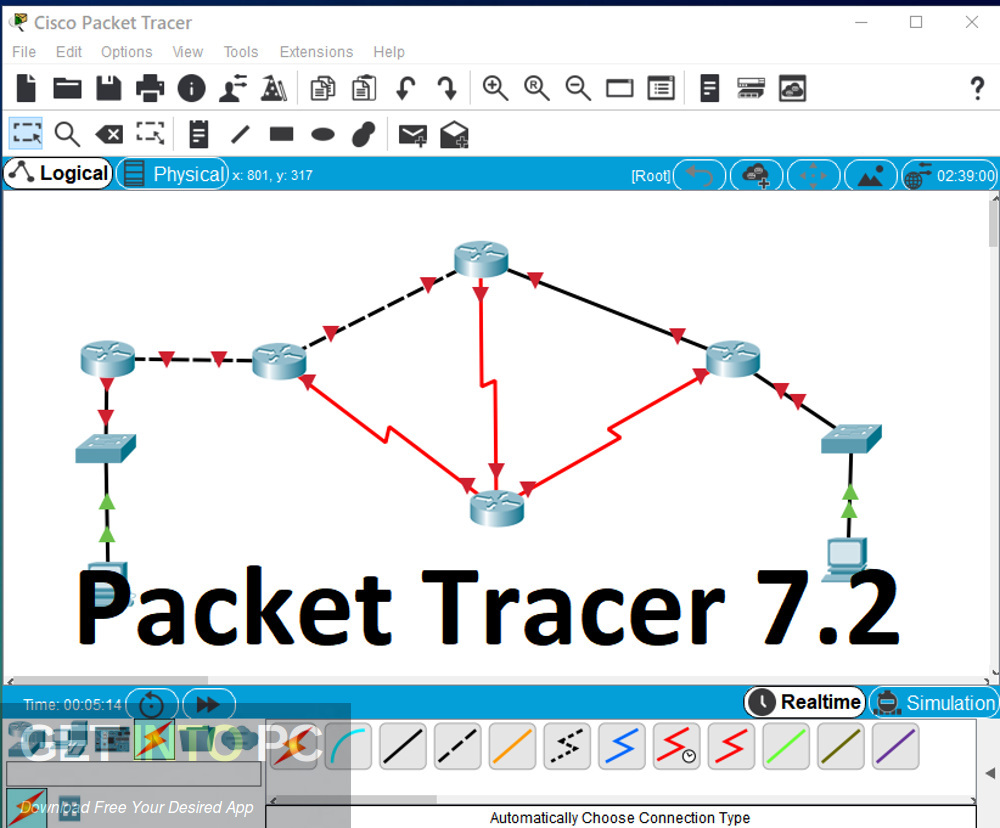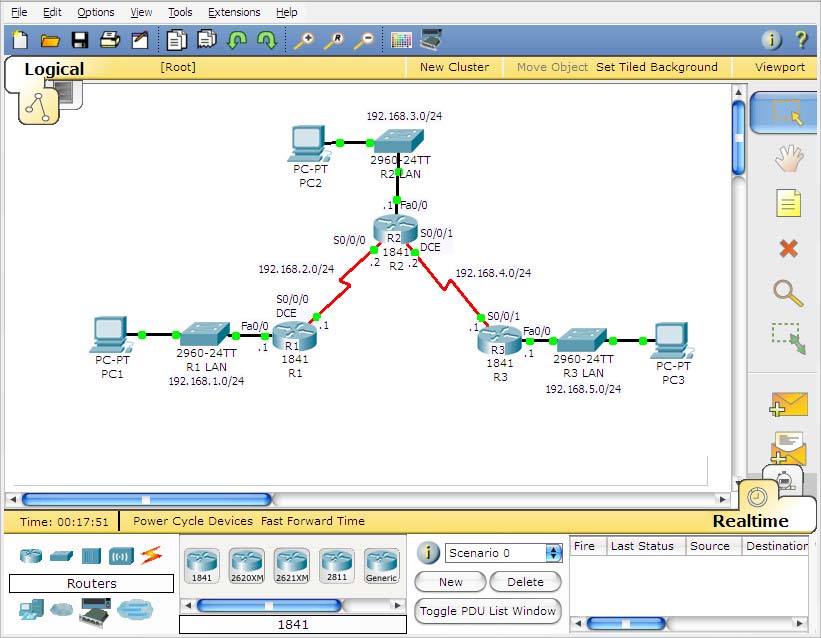17.8.1 Packet Tracer – Design and Build a Small Network – Physical Mode Answers
- Cisco Network Packet Tracer Download
- Cisco Packet Tracer Application
- Cisco Packet Tracer 7 Download
- Cisco Packet Tracer Setup Download
About Press Copyright Contact us Creators Advertise Developers Terms Privacy Policy & Safety How YouTube works Test new features Press Copyright Contact us Creators. Yes,Mathew the packet tracer is free. I got the info from the series of webinars that Cisco is currently running about the changes on the CCNA exam. The last one will be on Tuesday starting at 6h50 CAT.
Packet Tracer – Design and Build a Small Network – Physical Mode(Answers Version)
Answers Note: Red font color or gray highlights indicate text that appears in the Answers copy only.
Explain how a small network of directly connected segments is created, configured, and verified.
In this Packet Tracer Physical Mode (PTPM) activity, you will design and build a network from scratch.Your design must include a minimum of one Cisco4321 router, two Cisco 2960 switches, and two PCs.Fully configure the network and use IPv4 or IPv6 (subnetting must be included as a part of your addressing scheme).Verify the network using at least five show commands.Secure the network using SSH, secure passwords, and console passwords (minimum).
- What was the most difficult portion of this activity?
Type you answers here.
Answers will vary.
- Why do you think network documentation is so important to this activity and in the real world?
Type you answers here.
Documentation is imperative to good network management.Without it, network administrators have to recreate topologies, physically check addressing, etc. This takes time, which could be used elsewhere.
Create a small network of directly connected segments, at a minimum 1 router, 2 switches and 2 PCs, and include a screenshot of the network in your final documentation.
Sample Topology:
Configure the network to include switches, routers, and end devices and use your own network addressing.You must use subnetting of some type and you can use either IPv4 or IPv6 logical addressing. Create a table showing your physical addressing scheme for the router, switch, and PC and include it in your final documentation.
Device Name | IP Address | Subnet Mask |
Cap_rtr | G0/0/0 – 192.168.1.1 G0/0/1 – 192.168.1.33 | 255.255.255.224 255.255.255.224 |
Cap_sw1 | VLAN1 – 192.168.1.20 | 255.255.255.224 |
Cap_sw2 | VLAN1 – 192.168.1.62 | 255.255.255.224 |
Cap_PC1 | F0 – 192.168.1.10 | 255.255.255.224 |
Cap_PC2 | F0 – 192.168.1 40 | 255.255.255.224 |
Blank Line – no additional information
Verify the network by using show commands (at least 5) to provide a performance baseline. Be able to discuss why you chose the show commands you selected and what the output means (use all Packet Tracer activities for modules 1-17). Keep screenshots of your output and include in your final documentation.
Cap_rtr# show arp
ProtocolAddressAge (min)Hardware AddrTypeInterface
Internet192.168.1.1–00D0.9741.9101ARPAGigabitEthernet0/0/0
Internet192.168.1.101000A.4120.9039ARPAGigabitEthernet0/0/0
Internet192.168.1.33–00D0.9741.9102ARPAGigabitEthernet0/0/1
Internet192.168.1.40100D0.BCC3.BBEBARPAGigabitEthernet0/0/1
Internet192.168.1.6200060.4779.5A11ARPAGigabitEthernet0/0/1
Cap_rtr# show int g0/0/0
GigabitEthernet0/0/0 is up, line protocol is up (connected)
Hardware is Lance, address is 00d0.9741.9101 (bia 00d0.9741.9101)
Internet address is 192.168.1.1/27
MTU 1500 bytes, BW 1000000 Kbit, DLY 100 usec,
reliability 255/255, txload 1/255, rxload 1/255
Encapsulation ARPA, loopback not set


Full-duplex, 100Mb/s, media type is RJ45
ARP type: ARPA, ARP Timeout 04:00:00,
Last input 00:00:08, output 00:00:05, output hang never
Last clearing of “show interface” counters never
Input queue: 0/75/0 (size/max/drops); Total output drops: 0
Queueing strategy: fifo
Output queue :0/40 (size/max)
5 minute input rate 27 bits/sec, 0 packets/sec
5 minute output rate 23 bits/sec, 0 packets/sec
8 packets input, 1024 bytes, 0 no buffer
Received 0 broadcasts, 0 runts, 0 giants, 0 throttles
0 input errors, 0 CRC, 0 frame, 0 overrun, 0 ignored, 0 abort
0 input packets with dribble condition detected
7 packets output, 896 bytes, 0 underruns
0 output errors, 0 collisions, 1 interface resets
0 babbles, 0 late collision, 0 deferred
0 lost carrier, 0 no carrier
0 output buffer failures, 0 output buffers swapped out
Cap_rtr# show ip route
Codes: L – local, C – connected, S – static, R – RIP, M – mobile, B – BGP
D – EIGRP, EX – EIGRP external, O – OSPF, IA – OSPF inter area
N1 – OSPF NSSA external type 1, N2 – OSPF NSSA external type 2
E1 – OSPF external type 1, E2 – OSPF external type 2, E – EGP
i – IS-IS, L1 – IS-IS level-1, L2 – IS-IS level-2, ia – IS-IS inter area
* – candidate default, U – per-user static route, o – ODR
P – periodic downloaded static route
Gateway of last resort is not set
192.168.1.0/24 is variably subnetted, 4 subnets, 2 masks
C 192.168.1.0/27 is directly connected, GigabitEthernet0/0/0
L 192.168.1.1/32 is directly connected, GigabitEthernet0/0/0
C 192.168.1.32/27 is directly connected, GigabitEthernet0/0/1
L 192.168.1.33/32 is directly connected, GigabitEthernet0/0/1
Cap_sw1# show vlan brief
VLAN Name Status Ports
—- ——————————– ——— ——————————-
1 default activeFa0/1, Fa0/2, Fa0/3, Fa0/4
Fa0/5, Fa0/6, Fa0/7, Fa0/8
Fa0/9, Fa0/10, Fa0/11, Fa0/12

Fa0/13, Fa0/14, Fa0/15, Fa0/16
Fa0/17, Fa0/18, Fa0/19, Fa0/20
Fa0/21, Fa0/22, Fa0/23, Fa0/24
Gig0/1, Gig0/2
1002 fddi-default active
1003 token-ring-defaultactive
1004 fddinet-default active
1005 trnet-default active
Cap_sw2> traceroute 192.168.1.10
Type escape sequence to abort.
Tracing the route to 192.168.1.10
1 192.168.1.33 39 msec 0 msec 0 msec
2 192.168.1.10 13 msec 21 msec 15 msec
Secure the network using common configuration to include SSH, secure passwords, console security, etc. and verify the commands configured by enacting a show running-configuration screen as output. Include in your final documentation.
Cap_rtr# show run
Building configuration…
Current configuration : 831 bytes
!
version 15.4
no service timestamps log datetime msec
no service timestamps debug datetime msec
service password-encryption
!
hostname Cap_rtr
!
enable secret 5 $1$mERr$5.a6P4JqbNiMX01usIfka/
!
ip cef
no ipv6 cef
!
username SSHAdmin secret 5 $1$mERr$WvpW0n5HghRrqnrwXCUUl.
!
ip domain-name capstone.lab
!
spanning-tree mode pvst
!
Cisco Network Packet Tracer Download
interface GigabitEthernet0/0/0
ip address 192.168.1.1 255.255.255.224
duplex auto
speed auto
!
interface GigabitEthernet0/0/1
ip address 192.168.1.33 255.255.255.224

duplex auto
speed auto
!
Cisco Packet Tracer Application
interface Vlan1
no ip address
shutdown
!
ip classless
!
ip flow-export version 9
!
!
line con 0
password 7 0822455D0A16544541
login local
!
line aux 0
!
line vty 0 4
password 7 0822455D0A16544541
login local
transport input ssh
!
!
end
Identify elements of the model that map to real-world applications:
All facets of this activity map to IT-related content and real-world applicationsbecause this is a culminating activity for all themodules.
Table of Contents
Introduction
Cisco Packet Tracer is free software provided by Cisco Networking Academy for simulating computer and IoT networks, it’s useful if you want to learn that IT part where you can handle all those routers, networks problems, particular situations. The software simulation provides a graphical user interface and visual objects for users to design, build, configure, and test computer networks with add-on objects, such as switches, routers, servers, and various wireless connections. The software also allows to create and design IoT objects and networks such as a smart devices with interconnected home or build appliances. This part is focus on the study of automated IoT environment and skills through a software simulation approach using Packet Tracer. On the other hand, it’s available in multiple languages and multiple platforms (we will see for ubuntu)
Install Cisco Packet Tracer
This tutorial explains how to install a packet tracer on Ubuntu Linux.
First all you need to create a Cisco Network Academy Account Registration and after that select the Packet Tracer to Download, in the the Networking Academy portal page, access “Resources” -> “Download Packet Tracer”.
You should normally be able to install the .deb package directly, simply by double-clicking it to launch the appropriate installation program. But also you can use apt-get command line tools as follows.
During the above implementation, the following license agreement screen will appear, so select as shown in the image.
To start the Packet Tracer from a terminal, use the packettracer command.
When the startup is completed, the Packet Tracer screen will be displayed as shown below and this the important list of IoT devices.
- The Smart Things is separated into 5 subcategories : End Devicess, Home, Smart City, Industrial, and Power Grid.
- The Components are physical objects that connect to microcontroller and can be : Boards (microcontrollers), Actuators and sensors.
let’s get to work :)
Remote control of lamp with Cisco Packet Tracer
Use a web browser from your PC, tablet, or smartphone to connect to your home gateway or server and turn your IoT devices on and off.
Start the IoT environment
It is possible to see examples and use it to create a new one from scratch.
Go to File> Open Samples -> IoT -> IoT_Devices -> fan.pkt sample file.
The server, switch, and PC settings are still setting, so just remove all the rest of the part before.
Connect the switch and light.
Cisco Packet Tracer 7 Download
Connect the light side to FastEthernet0. The link will be up after a while. Link up when the triangle icon on the cable turns green.
Settings for IoT devices
Setting the light device with the following parameters:
- Display name
- Connection DHCP
- The remote IoT Server with the user and password to interact with it. (The server IoT still have static IP and the user/password with “admin”)
Remote access from PC
Now we will check if we can access and control the light with our PC.
Cisco Packet Tracer Setup Download
Access to your end device and in the Desktop execute the web browser with the IoT IP adress server.
Autorisation is requested.
In the web site you can see the lamp and the possible action.
Programming components
Cisco Packet Tracer supports Python, Blocky, and JavaScript to programm of the MCU-PT microcontroller and server.
Thank you for the initial photo.
Photo by Jonas Leupe on Unsplash